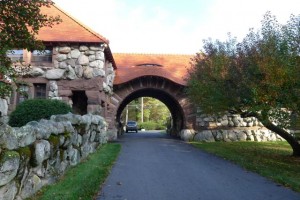The PSU Historic Preservation program was represented by six current and former students at this year’s Historic New England Field School in Preservation Practices, held in North Easton, Massachusetts. The village is distinguished by five H. H. Richardson-designed buildings, the largest cluster of his work anywhere. Built in the early 1880s, those buildings were financed by the Ames family, which operated a shovel manufactory in North Easton starting in 1803, and whose business interests later spread to railroads.
The field school’s topic was preservation easements, and attendees learned about using easements to preserve of historic properties—from initial identification and documentation of character-defining features to legal and tax issues to regular compliance monitoring and enforcement.

Portal at Ames Gate Lodge
The Ames Gate Lodge (1880-81), recently covered by a
Historic New England preservation easement, served as one of two study properties surveyed for special features and building conditions. It was a rare opportunity to look closely at this private residence, designed by H. H. Richardson, landscaped by Frederick Law Olmsted, and incorporating elements sculpted by Augustus St. Gaudens.
The nearby Old Colony Railroad Station, commissioned by Frederick Lothrop Ames, was designed and built by Richardson in 1881. Since 1969, the station has been owned by the
Easton Historical Society. Now used for museum and function space, it provided a central classroom for the field school.
Just across the railroad tracks is the Ames Shovel Works, an extended complex of stone buildings dating from the mid-1800s and operated until 1952. The structures were threatened by private redevelopment plans in 2009, but through a coordinated intervention, the property was purchased, preserved, and converted into
rental apartmentswithin the envelopes of the existing structures.


